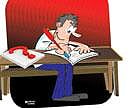
The impact that tests have on teaching and learning is called washback. Many research studies reveal that a test affects participants, processes and products in teaching and learning. Students, classroom teachers, administrators, material developers and text book writers may be included under ‘participants’. Their perceptions and attitudes towards their work are likely to be affected by a test. ‘Process’ refers to any action taken by the participants which may contribute to the process of learning. Material development, syllabus design, changes in teaching methodology and the use of learning and/or test-taking strategies are included under processes. ‘Product’ means what is learned (facts, skills, etc.) and the quality of the learning (fluency, appropriacy, etc.) Tests have an impact on the learning outcomes as well.
Negative impact
It is widely believed that tests have a negative impact on teaching and learning. Standardised tests such as Board examinations negatively influence the teaching-learning processes. Such tests are increasingly determining what is taught, how it is taught, what is learned, and how it is learned.
For example, the SSLC Board examination in Karnataka is mostly content/textbook based rather than competency/skills-based. This is truer in the case of language tests, especially English. The blue print for question paper design suggests 25% for knowledge type, 39% for comprehension type, 30% for expression type and another 06% for appreciation type questions (The fact that question paper setters/item writers themselves find it difficult to differentiate between these types of questions is a different matter!)
It is indeed difficult to evaluate the language learning experience of the learner using this type of classification. Moreover, nearly 60% of the questions are from the prose, poetry and supplementary reading parts of the text book. It is most unfortunate that the major content for the examination is drawn from the text book alone. Above all, the test items fail to assess the student’s ability to use language for communicative purposes. The items do not even measure the extent to which students have achieved the course objectives. Hence, it is neither a proficiency test nor an achievement test.
Skewed testing
The Board examination discussed above tests students’ lower level skills such as the ability to memorise, the ability to recall facts, etc. at the expense of higher level skills such as the ability to distinguish between a fact and an opinion, or the ability to organise ideas using appropriate cohesive devices. As a result of this, what happens is that only those skills which are tested in the examination get taught in the classroom. Teaching, thus, becomes textbook-centred and examination-oriented.
Take the case of reading, for instance. Reading is taught in the classroom only through the prescribed lessons such as prose, poetry and supplementary reading. A variety of authentic texts such as advertisements, notices, posters, newspapers, magazines, instruction manuals, etc. are not made use of for developing reading skills precisely because such materials are not used in the final examination for testing reading. Also, answers for reading comprehension questions are dictated in the classroom and are memorised by students. There is hardly any attempt made to develop skimming, scanning and other sub-skills of reading. Similarly, listening and speaking skills are neglected in the classroom because these skills are not tested in the examination. Conversation in the classroom is limited only to questions and answers. Little emphasis is laid on the systematic teaching of writing skills. Writing is not seen as a form of communication and students are not encouraged to create their own pieces of writing. All this happens because of the washback effect of the final examination.
Passive recipients
The washback effect can also be felt on what students learn and how they learn. Students are not active participants in the language acquisition process. They are passive recipients of the information given in the prescribed textbooks. Also, the practice of exam-specific strategies such as familiarisation with the exam format, special coaching, rote learning, resorting to exam-related published materials, etc. represent a very superficial level of learning outcome. There are now concerns about the narrowing of the curriculum, lost instructional time, reduced emphasis on skills that require complex thinking and problem-solving.
It is also worth mentioning that there are significant differences between the skills defined within the syllabus and the skills measured by the exam. It is claimed that the syllabus is based on a communicative approach to language teaching and the objectives of teaching English are to develop the language skills and to enable students to use the language for communicative purposes. The final examination, on the other hand, does not seem to evaluate how far students have achieved those curricular objectives.
Overhaul system
A way forward lies in overhauling the examination system. The change of the public examination could, to a large extent, change the teachers in their fundamental beliefs and attitudes about teaching and learning, the roles of teachers and students, and how teaching and learning should be carried out. This could also change the content of teaching, the interaction patterns between teachers and students, the way activities are carried out and the classroom processes.
Changing the examination pattern is not a panacea for all the perils of the system. However, it is a necessary condition for changing the teaching and learning behaviours of teachers and students.

